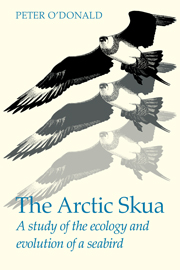Book contents
- Frontmatter
- Contents
- List of figures
- List of tables
- Preface
- 1 The Arctic Skuas of Fair Isle
- 2 Numbers and distribution
- 3 Feeding behaviour and ecology
- 4 Breeding ecology
- 5 Genetics
- 6 Demography and selection
- 7 Sexual behaviour
- 8 Sexual selection
- 9 Genetic models of sexual selection in birds
- 10 Mating preferences of the Arctic Skua
- 11 Conclusions
- Appendix A Rates of increase of bird populations
- Appendix B Analysis of variance of a 2 × r table with unequal numbers of observations
- Appendix C Statistical analysis of assortative and disassortative mating in polymorphic birds
- References
- Index
Appendix C - Statistical analysis of assortative and disassortative mating in polymorphic birds
Published online by Cambridge University Press: 21 May 2010
- Frontmatter
- Contents
- List of figures
- List of tables
- Preface
- 1 The Arctic Skuas of Fair Isle
- 2 Numbers and distribution
- 3 Feeding behaviour and ecology
- 4 Breeding ecology
- 5 Genetics
- 6 Demography and selection
- 7 Sexual behaviour
- 8 Sexual selection
- 9 Genetic models of sexual selection in birds
- 10 Mating preferences of the Arctic Skua
- 11 Conclusions
- Appendix A Rates of increase of bird populations
- Appendix B Analysis of variance of a 2 × r table with unequal numbers of observations
- Appendix C Statistical analysis of assortative and disassortative mating in polymorphic birds
- References
- Index
Summary
Introduction to the theory of assortative mating
Assortative mating occurs when one or more phenotypes mate more often than at random with others like themselves. It is the tendency of like to mate with like. Disassortative mating, or negative assortative mating, is the tendency of unlike phenotypes to mate with each other.
Assortative mating has often been observed between phenotypes in polymorphic populations. It evolves as sub-populations become ethologically isolated. It can evolve without the isolation or sub-division of populations if mating preferences are selected in favour of particular phenotypes: the genes for the preferences increase in frequency in association with the genes for the preferred phenotypes; the association between the genes produces assortative mating (O'Donald, 1980a). Behavioural mechanisms such as imprinting on parental phenotypes produce assortative mating (Cooke, 1978). We should expect to observe and do observe, that assortative mating takes place in many polymorphic populations.
Disassortative mating has also been observed, though it does not seem to follow from simple evolutionary or behavioural mechanisms. The obvious example of disassortative mating is sex itself, which has still to be explained satisfactorily in terms of selective advantage (Maynard-Smith, 1978). Self-incompatibility systems are other examples. Disassortative mating between the sexes is of course complete: all fertile matings are males × females. Apart from these special mechanisms preventing asexual reproduction or inbreeding, a partial tendency to disassortment in matings between different phenotypes has been observed in certain polymorphic populations of birds.
- Type
- Chapter
- Information
- The Arctic SkuaA study of the ecology and evolution of a seabird, pp. 291 - 308Publisher: Cambridge University PressPrint publication year: 1983



